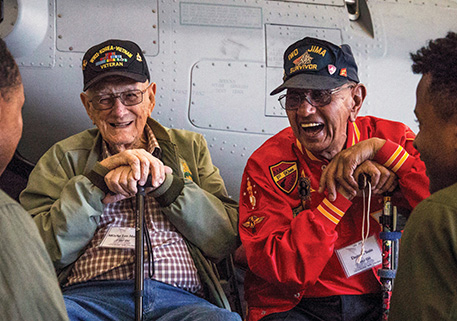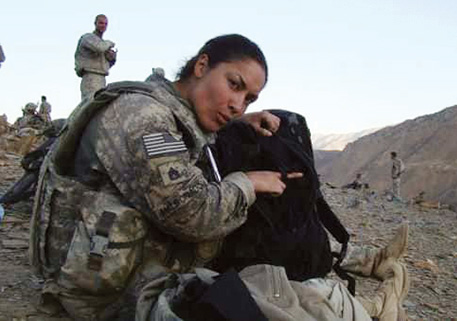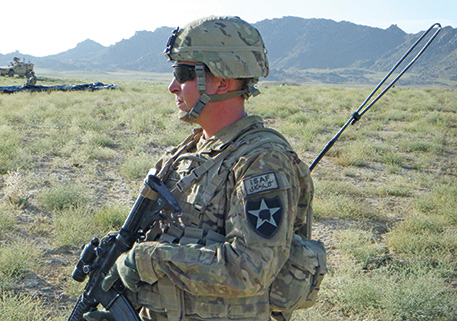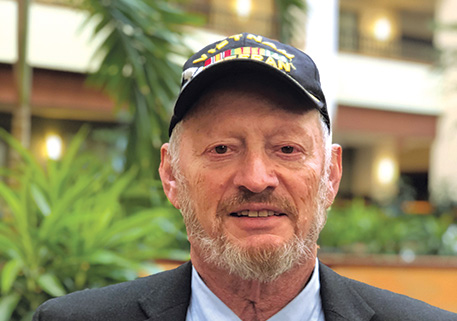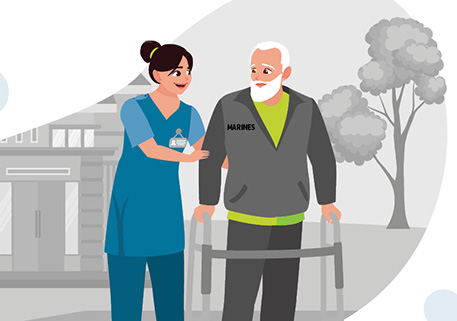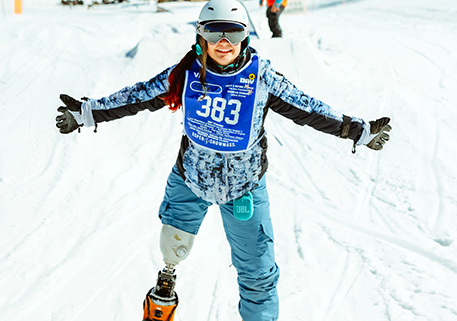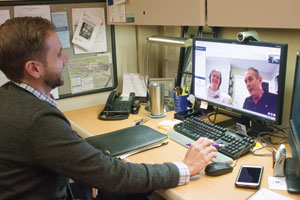
How technology is giving veterans new options
Navy veteran Mark Doyle’s life changed in a heartbeat in the summer of 2004 when he took a 25-foot fall on the ship he was serving aboard, landing on the back of his head and neck.
While he miraculously suffered no spinal damage, it wasn’t long before he started to exhibit symptoms of a serious traumatic brain injury (TBI): severe headaches, migraines, vision problems, disorientation, sleep problems and reduced memory.
In the 15 years since his injury, those symptoms have not subsided, but the surge in technology over the past decade has helped Doyle come a long way in his recovery.
Doyle and his wife, Bonnie, live 36 miles from Edward Hines Jr. VA Hospital in Chicago, which can be an excruciatingly difficult journey if he has an intense migraine. Doyle is unable to drive and depends on his wife to take him to his appointments. However, thanks to the VA’s telehealth option, he can still keep his appointment with his therapist from the comfort of his home.
This hasn’t always been the case.
“I first tried telehealth when you had to go to an outpatient-based clinic because that’s where the equipment was located,” said Doyle. “I didn’t like it. It was a room with dividers and people were on either side. I could hear them, so I know they could hear me. It was very unnerving.”
Now technology has changed telehealth and taken it to new heights. With a webcam and an internet connection, patients can have a session from home with their doctors and feel safe in a private, secure environment.
After his first experience with telehealth, Doyle was very reluctant to try this new option, but he decided to give it a go.
“About a month after seeing Dr. [Jonathan] Hessinger once a week, sometimes several times a week, I finally gave in and tried it. And I like it,” he said. “I’ve never felt like there were ‘listening ears.’ I know his office is secure. I also know there are offices next to him and I’ve never been able to hear anyone, so I’m comfortable that no one can hear me.”
“Telehealth has grown in leaps and bounds,” said Hessinger, a psychologist at the hospital’s TBI/Polytrauma Services Program. “We’re able to knock down the barriers that keep veterans from seeking help. Coming to the first appointment, walking into the mental health building can be difficult. With telehealth, I can come to you.”
Hessinger recalls a woman veteran who needed support but was very uncomfortable walking into a clinic full of men. He began working with her via telehealth, and after several months, she was comfortable enough to come to the clinic and meet.
“These are veterans we never saw five years ago,” said Hessinger. “Telehealth has changed the game for allowing access to people who are concerned about the stigma.”
“DAV has long advocated for expansions to e-health and telemedicine options, knowing not only what a tremendous benefit it can be to severely disabled and rural veterans as well as those who have experienced trauma, but also how cost-effective it is for the VA,” said Deputy National Legislative Director Adrian Atizado. “In fact, it’s something DAV members have established as a priority for us legislatively through the resolution process, so we know it’s important to them.”
Veterans might think sessions would be less personal in that environment, but research has shown there’s no difference.
“It’s still a working alliance,” said Hessinger. “Some veterans report greater satisfaction because they didn’t have to drive in.”
Additionally, smartphone applications are also working to enhance the health care landscape.
“When my treatment began, I was using lists and writing everything down, and at the end of the day I would have seven or eight lists,” said Doyle. “For someone with memory problems, it became frustrating and confusing, because I had to manage all my lists and remember where they were.”
The information and tracking activities with lists and notes were overwhelming for Doyle. Working with Hessinger, Doyle is using smart apps to help with multiple issues, harnessing the power of technology to monitor pain, anxiety, sleep therapy and memory problems. With Migraine Buddy, Doyle can track this migraine triggers. He can track responses to situations with CPT Coach. He can practice guided relaxation exercises with Mindfulness Coach. All of these resources are right at his fingertips on his phone.
“Notes are time- and date-stamped, so I can easily reference them instead of having to dig through piles of notes,” said Doyle.
“We’d give out a lot of binders to clients for homework, exercises and journaling between sessions,” said Hessinger. “But people can lose binders or stuff them in the back seat of the car and forget about them until it’s time for the next session. Our phones are always with us. The apps can allow clients to have to access their work and set reminders.”
Doyle encourages his fellow veterans to try telehealth and available applications if they are concerned about missing appointments.
“You have to give it time and keep the lines of communication open,” said Doyle. “You’re not going to get a magic pill. You have to do the work.”
While Doyle said he’s not where he wants to be and says he has a long way to go, he has hope for the future after overcoming so many obstacles.

